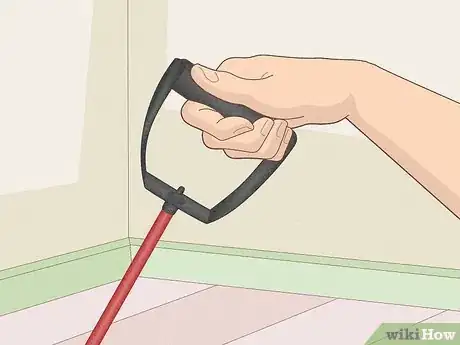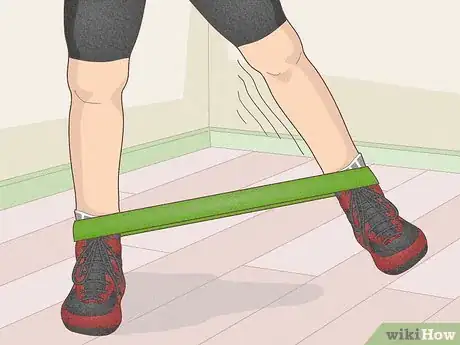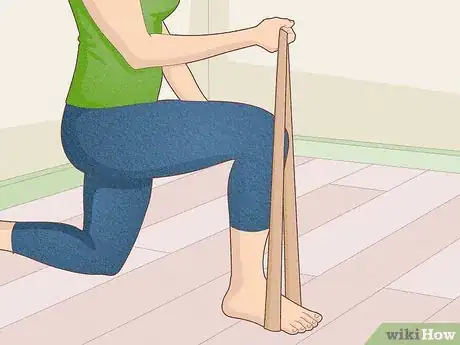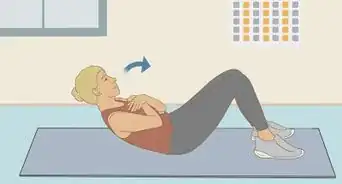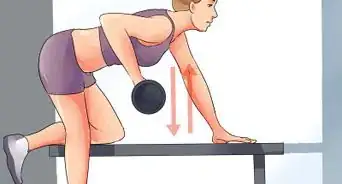This article was co-authored by Brendon Rearick and by wikiHow staff writer, Eric McClure. Brendon Rearick is a Personal Trainer, Strength Coach, Fitness Program Director, and co-founder of Certified Functional Strength Coach (CSFC), a fitness education company in the San Francisco Bay Area. With 17 years of experience in the fitness industry, Brendon specializes in strength and conditioning, and his company CSFC has certified over 3,000 trainers in over 20 countries. Brendon has worked as a Program Director for Mike Boyle Strength and Conditioning (MBSC) and earned his massage therapy license from the Cortiva Institute-Boston. Brendon holds a BS in Kinesiology from the University of Massachusetts Amherst.
There are 14 references cited in this article, which can be found at the bottom of the page.
This article has been viewed 25,978 times.
Resistance bands are one of the most popular options out there when it comes to workout equipment. These flexible latex bands look like small loops made out rubber or latex, and they typically come in color-coded sets of 4, 5, 6, or 8 depending on how many options you’d like. Not only are they incredibly versatile in terms of the exercises you can do with them, but they’re super easy to store, they’re cheap, and you can take them with you basically anywhere. But with so many products out there, you may be wondering which set is right for you. The good news is that most resistance band sets are more or less interchangeable, and it’s way more important to understand how to select the proper level of resistance than it is to choose the fanciest brand.
Steps
Are resistance bands color coded?
-
1Yes, and the colors are basically universal among the major brands. There may be some very minor variation in strength and resistance from one brand of bands to another, but basically every band uses the same color-coding system.[1] The most popular sets out there are usually have 4, 5, 6, or 8 bands in them. There’s usually a reference card that comes with every set as well. Regardless, this is typically what the colors mean:[2]
- Tan—XX-light
- Yellow—X-light
- Red—Light
- Green—Medium
- Blue—Heavy
- Black—X-heavy
- Silver—XX-heavy
- Gold—XXX-heavy
-
2If you’re ever unsure, assume the lighter colors have less resistance. There are a handful of niche brands that like to play around with the colors for branding reasons, and who can blame you if you lose that tiny reference card that comes with these sets? If you’re ever unsure, just assume that the lighter colors have less resistance and the darker colors have more resistance. On top of that, the thicker the band is, the more resistance there will be. All things considered, it shouldn’t be too hard to figure out which bands have more resistance.[3]
- If you’re worried about losing track of which band is which, label each band by writing the resistance level on them with a permanent marker as soon as you buy them.
What set of resistance bands should I buy?
-
1Get standard large loop bands if you want versatility. The vast majority of resistance bands are large loop bands. They’re closed loops with no handles, and they give you the highest number of options when it comes to available workouts. They come in a variety of different lengths, but you can always wrap them around your anchor or feet more than once to artificially make them shorter if necessary.[4]
- If you know you won’t need a ton of resistance or you’re buying the bands to do physical therapy exercises at home, buy therapy bands. They’re the same thing as loop bands, but these sets usually have a lighter resistance.[5]
-
2Buy mini-bands if you’re a little short on space. Mini-bands are the same thing as large loop bands, except they’re a lot smaller and the resistances are condensed. In other words, a light large loop band and a light mini-band will provide the same level of resistance, but you won’t need to pull the light band out super far. This makes them ideal if you’re doing home workouts in a small space.[6]
- With mini-bands, you may not be able to do a lot of standing exercise where the bands wrap around your feet, but you can actually use them for a variety of exercises where they wrap around your ankles, thighs, and wrists, which can be difficult with bigger bands.
- There are also figure-8 bands out there. They usually have handles, and they’re designed for upper body exercises. They aren’t super popular, but they’re a good choice if you only want the bands for a handful of chest and arm exercise.[7]
-
3Get bands with handles if you want a better grip. If you only want the resistance bands for upper body exercises and you want maximum wrist comfort, buy a set with handles. These bands are typically a little more expensive, but they’re worth it if you want to keep your hands comfortable while you’re working out![8]
- Since you can only hold the handles with your hands, you can’t do any lower body exercise where the bands need to be wrapped around your legs.
How do I know if I’m using the wrong resistance band?
-
1So long as you control the band and feel the burn, it’s fine for you. Lighter bands are likely better if you want to tone muscle and build endurance, while heavier bands are probably going to be better for building strength. With that said, so long as you’re exhausting your muscles by the end of your workout you’re going to benefit from the exercise.[11] The only way a band can be wrong for you is if it’s so easy to use that you don’t feel anything, or the band is so strong that you can’t physically control the movements.[12]
-
2If you’re rehabbing an injury, use a lighter resistance if you feel pain. If a certain resistance band is causing your injury to flare back up or you feel pain while you’re using it, stop. Switch to a lighter band that’s easier for you to use. If you’re in physical therapy, let your trainer know that it’s causing you issues so they can pick something more appropriate for you. Resistance bands are popular in treatment settings because they’re so flexible and easy to use, but these exercises shouldn’t hurt.[13]
- You don’t want the band to be so easy to move that you have to stretch it out super far to accomplish an exercise. It’s rare, but the bands can snap if you pull them out too far.
References
- ↑ https://www.consumerreports.org/cro/2012/05/get-in-shape-on-the-cheap/index.htm
- ↑ https://blog.allegromedical.com/breaking-the-code-of-resistance-band-colors-2286.html
- ↑ https://www.consumerreports.org/cro/2012/05/get-in-shape-on-the-cheap/index.htm
- ↑ https://www.shape.com/fitness/tips/how-use-resistance-bands
- ↑ https://www.shape.com/fitness/tips/how-use-resistance-bands
- ↑ https://www.shape.com/fitness/tips/how-use-resistance-bands
- ↑ https://www.shape.com/fitness/tips/how-use-resistance-bands
- ↑ https://www.nytimes.com/wirecutter/reviews/best-resistance-bands/
- ↑ https://www.nbcnews.com/better/lifestyle/one-month-resistance-band-workout-you-can-do-anywhere-ncna965461
- ↑ https://www.nbcnews.com/better/lifestyle/one-month-resistance-band-workout-you-can-do-anywhere-ncna965461
- ↑ https://elementssystem.com/wp-content/uploads/2018/04/Schoenfeld-17-altas-bajas.pdf
- ↑ https://www.shape.com/fitness/tips/how-use-resistance-bands
- ↑ https://www.theolympian.com/living/health-fitness/article25313293.html
- ↑ https://www.insider.com/resistance-bands-vs-dumbbells-weights#exercises-you-can-do-with-resistance-bands
- ↑ https://greatist.com/fitness/resistance-band-exercises
- ↑ https://www.acefitness.org/getfit/rubrbndwkout.pdf
- ↑ Brendon Rearick. Personal Trainer & Strength Coach. Expert Interview. 30 July 2020.
- ↑ https://www.insider.com/resistance-bands-vs-dumbbells-weights
- ↑ https://www.vice.com/en/article/xwkbqk/this-is-how-to-put-on-muscle-without-lifting-super-heavy
- ↑ Brendon Rearick. Personal Trainer & Strength Coach. Expert Interview. 30 July 2020.




